Intel Kaby Lake: 7 Things to Know About 7th-Gen Core CPUs
Intel has a new family of processors. Dubbed Kaby Lake, the 7th-Generation Core processors should be of particular interest if you're making do with an older machine, like to stream a lot of high-resolution video or enjoy gaming on the go — or some combination of all three.
During the Intel Developer Forum, we got a taste of what the 7th-Gen Core processors could do. During a demo at the forum, a Dell XPS 13 laptop was able to play the graphically demanding game Overwatch, using standard integrated graphics on the new platform. We've since reviewed the Kaby Lake XPS 13 and found its performance to be noticeably better.
We now have a better idea of just how these CPUs will power the performance of an upcoming spate of notebooks, 2-in-1s and other computers.
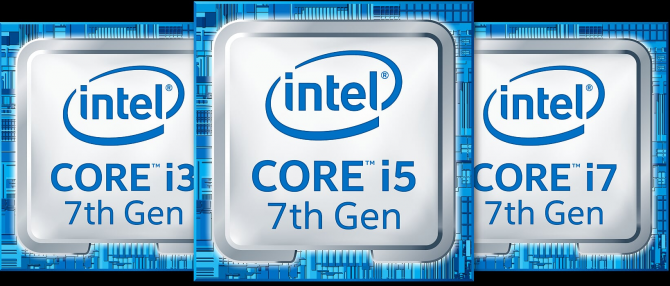
Here's what we know so far about Intel's 7th-Gen Core processors:
1. Core-powered machines are here.
Chris Walker, Intel's general manager for mobile client platforms, said new processors from 4.5-watt to 15-watt will be the first to arrive, powering new 2-in-1s and ultrathin notebooks. Look for 100 designs featuring 7th-Gen Core processors to be available by the fourth quarter of 2016, Walker said.
The new processor family will expand to other markets in January — specifically, enterprise, workstations, performance gaming and virtual reality, Walker said. That will mean more notebooks aimed at enthusiasts, as well as desktops with the 7th-Gen Core CPUs.
2. These chips have a familiar architecture.
Intel built the 7th-Gen Core chips on the same Skylake architecture it introduced last year, so don't look for Intel to reinvent the architecture but rather refine it.
Get The Snapshot, our free newsletter on the future of computing
Sign up to receive The Snapshot, a free special dispatch from Laptop Mag, in your inbox.
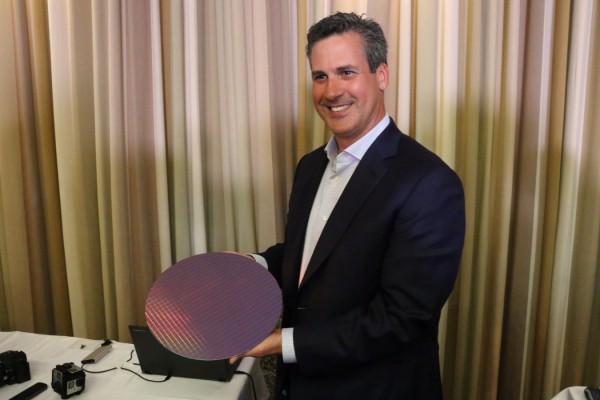
Specifically, Intel said it improved the transistor channel strain on these CPUs. The result is a microarchitecture that's more power-efficient, so that the 7th-Gen Core chips can offer a performance boost over previous generations of Intel processors.
3. The Core m5 and m7 names are going away.
Intel has made a change to the way it names its low-power chips, eliminating the Core m5 and Core m7 designations and turning those two 4.5-watt chips into Core i5 and Core i7-branded SKUs. The company hopes this change will help consumers, many of whom didn't understand the difference between a Core i5 and a Core m5. However, because the 4.5-watt CPUs, also known as Kaby Lake Y series chips, are lower-power, they won't perform the same as a U series 15-watt CPU. If you see a "Y" at the end of the SKU, you have one of the chips formerly known as Core m5 or m7.
To make matters more interesting, Intel is keeping the Core M brand for its entry-level Core m3 chip, which is the slowest and least expensive of the bunch. So in order of performance, the 4.5-watt chips are named Core m3, Core i5 Y series and Core i7 Y series.
4. You'll see performance gains over last year's CPUs.
You're probably not going to ditch that Skylake-powered machine you picked up last winter in favor of one with a 7th-Gen Core CPU. But Intel says that if you were to do so, you'll notice a faster machine. Using SYSmark to measure productivity, Intel found a machine powered by a 7th-Gen Core i7-7500U processor notched a 12 percent gain over a 6th-Gen Core i7-6500U CPU. That 7th-Gen-powered machine also recorded a 19 percent boost in web performance as measured by WebXPRT 2015.
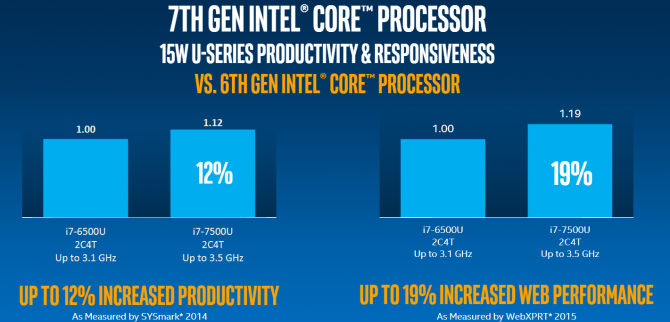
Obviously, the performance increases look more substantial when stacked up against older PCs, and that's where Intel is betting most of the upgrades to 7th-Gen chips are going to come from. A new Core i5-7200U-powered machine recorded a 1.7x improvement over a five-year-old Core i5-2467M in SYSmark. On the 3DMark Cloud Gate Graphics test, Intel said the new CPU tripled that five-year-old machine's score.
Intel representatives told us that 7th-Gen Core CPUs could play Overwatch on medium settings at 720p with integrated graphics or at 4K with a compatible graphics amp. Kaby Lake won't kill gaming laptops, though, as hard-core players will want to play in 1080p at the minimum.
5. These chips are designed for video.
Intel has taken notice of all of the 4K and 360-degree video we're consuming. In response, the chipmaker introduced a new video engine to its 7th-Gen Core processors that aims to handle whatever content demands you can throw at it.
The new chips add HEVC 10-bit decode capability, which should let you play back 4K ultra-HD video without any hiccups. Intel also added VP9 decode capability to the 7th-Gen Core chips to boost power efficiency when you're watching those 4K and 360-degree videos while also performing other tasks.
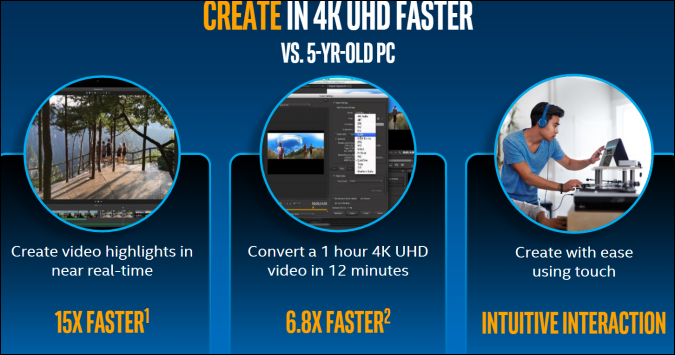
The chips will also create video content a lot faster. For example, according to Intel, you'll be able to transcode a 1-hour, 4K video in just 12 minutes.
6. The chips are more power efficient during playback.
In terms of the battery boost you'll see, Intel said the 7th-Gen Core machine can last for 7 hours when streaming 4K and 4K 360-degree YouTube video, compared with the 6th-Gen Core processor's 4 hours of battery life when handling the same demands. As for 4K streaming video, Intel is promising all-day battery life, or 9 and a half hours with the 7th-Gen Core processors.
7. Intel looks to boost performance in other ways.
The 7th-Gen Core processors offer a few other features aimed at making your laptops perform more efficiently, such as Intel's Turbo Boost 2.0 technology. That's the feature that manages both processor performance and power so that tasks get more processing oomph when they need it. Hyper-Threading Technology helps the CPUs complete tasks faster by delivering two processing threads for each core.
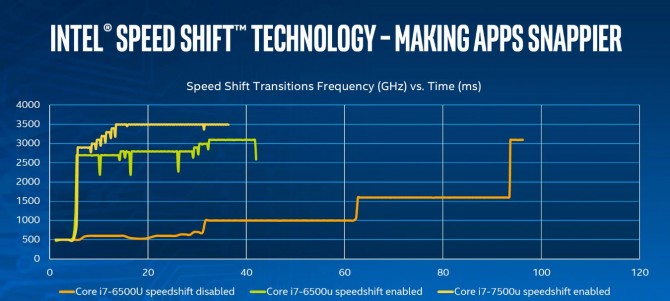
The 7th-Gen Core chips also include Speed Shift technology, which should make for speedier apps. The technology allows a processor to more quickly settle on its best operating frequency, thus optimizing performance and efficiency. This pays off particularly when you're performing short bursts of activity, such as browsing the web.
Laptop Guide
- Laptop Buying Guide: 8 Essential Tips
- The Best & Worst Laptop Brands
- Laptop Tech Support Showdown: Undercover Report
- Should I Buy a Chromebook? Buying Guide and Advice
- Laptops with the Longest Battery Life
- Chromebooks vs. Windows 10 Laptops: What Should You Buy?
- Why You Shouldn't Buy a Touch-Screen Laptop
- Out of the Box Tips: Set Up Your New Laptop Like a Pro
- The Best Time to Buy a Laptop
- Chromebook vs. Tablet: Which Should You Buy?
- Laptop Buying Tips for Students
- 10 Key Features to Look for in Your Laptop
- How to Buy a 2-in-1 Laptop Hybrid
- USB Type-C FAQ: Everything You Need to Know
- How to Get Rid of Your Old Laptop
- Laptop Warranties: What They Cover
- Which CPU is Right For You?
- Which Laptop Features Are Worth the Money?
- Gaming Laptop Buying Guide: Find the Right Rig
- 10 Reasons Why Consumers Should Buy Business Laptops
- Which MacBook is Right for You?
- 5 Things to Look For in Your Next Laptop Keyboard
- How to Configure Your Laptop: Specs That Matter
- Which Graphics Card Do You Need?
- The Perfect Laptop? Here’s What It Should Have
- Why 78 Percent of Laptop Screens Suck
- A Guide to Computer Ports and Adapters
- 13 Ways to Make a Slow Laptop Faster
- How to Tell If You Can Upgrade Your Laptop
- Laptop Locks Guide: Do You Need One?
- 10 Features You Can Skip to Save Money
